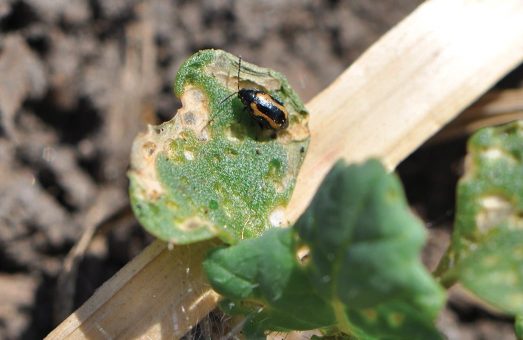Take time needed for neonic review
Flea beetle seed treatments clothianidin and thiamethoxam, both in the neonicotinoid family, are under separate registration reviews by the Pest Management Regulatory Agency (PMRA), the Health Canada agency that oversees pesticide registration in our country. Clothianidin is in Prosper and Poncho seed treatments. Thiamethoxam is in Helix and Cruiser Maxx seed treatments.
PMRA decisions on these two reviews are expected in the early months of 2019. If the PMRA moves forward with a phase-out, these two seed treatments would not be available after 2024.
The formal consultation period closed for the neonic review on November 13, 2018. The Canola Council of Canada (CCC) and Canadian Canola Growers Association (CCGA) made a submission clearly articulating why these proposed decisions should be reconsidered, highlighting how losing these products will dramatically impact competitiveness.
“The CCC agronomy team estimates that losing neonic seed treatments would cost growers $700 million and jeopardize our ability to achieve our sustainability goals.”
“The CCC got involved because we want to help ensure that growers can profitability and sustainably grow canola, and to do that, they need access to the right tools,” says Curtis Rempel, CCC vice president of crop production and innovation. “The CCC agronomy team estimates that losing neonic seed treatments would cost growers $700 million and jeopardize our ability to achieve our sustainability goals.”
Rempel says a targeted seed treatment is a valuable tool in canola stand establishment. The crop needs protection from flea beetles, which is the top insect pest of canola in Canada, and the alternative to seed treatment is above-ground foliar sprays. “The proposed ban on clothianidin and thiamethoxam seed treatments will result in increased frequency of foliar insecticide applications. This is never the first choice for our growers who are always looking for more targeted, more effective and less invasive pest control options,” read the CCC and CCGA letter to the PMRA.

While the formal consultation period is over, the CCC’s work continues. Additional information on effective risk mitigation strategies will be submitted and technical meetings will be organized to ensure PMRA scientists fully understand the impact on the canola industry. The CCC will continue to request that no formal decisions on clothianidin and thiamethoxam be made before the PMRA has received and fully considered all relevant scientific information, especially on how the risk to aquatic invertebrates could be effectively mitigated by our industry.
Ryan Prosser, a University of Guelph scientist who studies the impact of chemicals on aquatic and terrestrial ecosystems, was quoted in the CCC and CCGA letter saying that the water monitoring data the PMRA is currently using are overly conservative and greatly overestimate the true levels of neonics in waterways. Prosser says more research is needed.
“We understand the importance of monitoring waterways for pesticides so regulators have confidence in the sustainability of our crop,” Rempel says.
Rempel is co-chair of the Environmental Monitoring Working Group, which coordinates the sampling and analysis of wetlands and flowing water across Canada. This pan-Canadian water monitoring program now has two years of surface water monitoring data for neonicotinoids. “What is needed is an interpretation of the data in context of cropping systems, tillage practices, local moisture events and climatic patterns, soil characteristics and other variables to determine why and how exceedances have occurred in order to effectively mitigate risk,” Rempel says. “It’s important that decisions are made with the best available information. That means we need to have sufficient time for thorough analysis and follow up experimentation in 2019.”
Rempel says the PMRA provided useful guidance and collaboration for the working group’s water sampling and analysis. “We now need the time to interpret that data,” he says.





